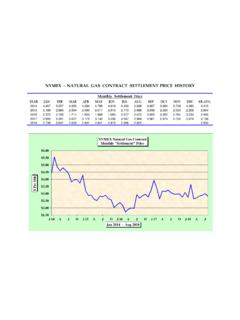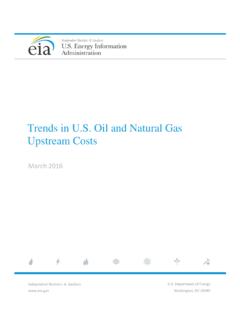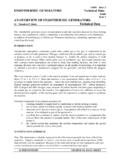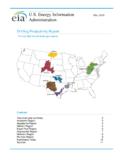Transcription of Natural gas pricing in India - EY
1 Natural gas pricing in India Current policy and potential impact Contents Current scenario in India 's Natural gas market Intricacies of Natural gas pricing in India Potential impact of new pricing on energy industry 2 Natural gas pricing in India Current policy and potential impact Chapter 1. Current scenario in India 's Natural gas market India 's Natural gas consumption far behind the global average1. India 's expanding economy and growing population have led to increased consumption of primary energy resources such as coal, oil and Natural gas in the country. In line with this, its primary energy consumption grew at a compounded annual growth rate (CAGR) of 6% to million tonnes of oil equivalent (MTOE) in 2012 from MTOE in 2007.
2 The share of Natural gas in its primary energy mix increased marginally from 8% in 2008 to in 2012. This is fairly low, compared to the global average of 24%, primarily due to supply-side constraints. Furthermore, in terms of individual consumption, India 's annual gas consumption of 44 cubic meters (cm) per capita is far behind the global average of 470 cm per person. Figure 1: Low consumption of Natural gas in India , 2012. 3,000. Per capita gas consumption, cubic meter Canada Russia 2,500 US. 2,000. Singapore 1,500 UK. Australia Malaysia 1,000 South Korea Germany Japan Turkey 500 France China Brazil 0 India -500. Gas share in energy mix, %. Source: BP Statistical Review of World Energy 2013, The World Bank and EY analysis Ka_fa [Yfl _Yk \] [al \]eYf\ ^gj kmhhdq ljYadk3 af[j]Ykaf_.
3 Reliance on imported LNG. Af\aY k fYlmjYd _Yk eYjc]l ak k]]af_ Y kmhhdq \] [al$ hjaeYjadq \m] lg dgo \ge]kla[ . production and an inadequate transmission and distribution infrastructure. Domestic _Yk hjg\m[lagf j][]an]\ Y ka_fa [Yfl aeh]lmk oal` [gee]f[]e]fl g^ hjg\m[lagf Yl . l`] C?%<. ]d\$ dg[Yl]\ af l`] [gmfljq k l`] ]Ykl [gYkl$ af *((1& @go]n]j$ l`] ]d\ k . output has been steadily declining after reaching 60 million standard cubic metres per day (mmscmd) in 2010, and has hit a trough of 12 mmscmd in 3 QFY142. According to Reliance Industries Limited (RIL), the fall in KG-D6's production is mainly due to _]gdg_a[Yd [gehd]palq Yf\ Y fYlmjYd \][daf] af l`] ]d\k& L`] \][daf] af egkl g^ l`] . [gmfljq k Y_]af_ ]d\k `Yk ^mjl`]j [gehgmf\]\ l`] kmhhdq \] [al&.))
4 Gf l`] gl`]j `Yf\$ l`] \]eYf\ ^gj fYlmjYd _Yk af Af\aY `Yk af[j]Yk]\ ka_fa [Yfldq \m] . to the demand from the power and fertilizer sectors, and cumulatively accounted for more than 61% of gas consumption in FY13. The demand is also driven by its growing mkY_] af l`] [alq _Yk \akljaZmlagf ;?<! k][lgj Yf\ af\mkljaYd k][lgjk$ km[` Yk j] faf_ . Natural gas pricing in India Current policy and potential impact 3. and petrochemicals. Rising concerns on carbon emission have also contributed to the demand for Natural gas in the L`ak `Yk d]\ lg Af\aY k af[j]Yk]\ \]h]f\]f[] gf aehgjl]\ daim] ]\ fYlmjYd _Yk DF?!& . L`] [gmfljq k DF? aehgjlk `Yn] af[j]Yk]\ ^jge YhhjgpaeYl]dq 0 eaddagf e]lja[ lgfk . eel! af >Q(1 lg )) eel af >Q)+$ Y[[gmfl]\ ^gj *0 g^ l`] lglYd kmhhdq&4 According to the BP Statistical Review of World Energy 2013, India is the world's fourth-largest aehgjl]j g^ DF?
5 Af l`] ogjd\& . Dac]da`gg\ g^ Af\aYf _Yk eYjc]l j]eYafaf_ af kmhhdq \] [al . despite rising production and import of gas Over the next few years, the shortfall in Natural gas production in the country is expected to continue with its supply trailing demand. Shortage of gas is likely to reach its peak in FY15, with around 37% of the demand being @go]n]j$ ^jge >Q).. gfoYj\k$ l`] \] [al eYq \][j]Yk]$ hjaeYjadq \m] lg l`] hdYff]\ hjg\m[lagf g^ hjanYl]'. bgafl n]flmj] [gehYfa]k Yf\ af[j]Yk]\ DF? aehgjl [YhY[alq& Hgo]j Yf\ ^]jladar]jk Yj] . expected to remain the anchor segments that consume Natural gas and are likely to account for around 68% of the total demand for it in FY17. Furthermore, deregulated pricing of petroleum products and an increasing focus on addressing environmental concerns are expected to drive the demand for Natural gas from industrial users, j]ka\]flaYd mk]jk l`jgm_` hah]\ fYlmjYd _Yk HF?
6 !$ Yf\ af l`] ljYfkhgjlYlagf k]_e]fl . l`jgm_` l`] \]eYf\ ^gj [gehj]kk]\ fYlmjYd _Yk ;F?!& @go]n]j$ l`ak \]eYf\ ak `a_`dq . price-sensitive and will depend on the price affordability of end users, especially in the power and fertilizer Figure 2: Future Natural gas demand-supply scenario (mmscmd). 148 LNG imports 135 140. 114 Domestic production Natural gas demand 87 149 371 87 170 405 129 177 446 150 209 473. De cit FY14 FY15 FY16 FY17. Source: Ministry of Petroleum and Natural Gas L`] lglYd kmhhdq g^ fYlmjYd _Yk ak ]ph][l]\ lg j]Y[` lg +-1 eek[e\af >Q)/$ Y ;9?J . of 15% from FY14 in India . Most of this incremental supply is expected to be met Zq DF? aehgjlk$ kaf[] l`] _jgol` af \ge]kla[ kmhhdq oadd ^Yad lg c]]h hY[] oal` l`].
7 Yfla[ahYl]\ jak] af \]eYf\& L`] [gmfljq k hgl]flaYd lg aehgjl DF? ak ]ph][l]\ lg . increase to 150 mmscmd in FY17, contributing around 42% of the total supply. Domestic production is expected to increase at a CAGR of around 12%.7 This is likely to come from new discoveries which are currently under development, expectation of partial recovery in the output from KG-D6 and increased production from unconventional sources, particularly coal bed methane. 4 Natural gas pricing in India Current policy and potential impact Chapter 2. Intricacies of Natural gas pricing in India Hj]nYadaf_ fYlmjYd _Yk hja[af_ j]_ae] af l`] [gmfljq . complex and heterogeneous There are multiple Natural gas pricing regimes in India . These can be divided into the following: Administered pricing Mechanism (APM).
8 Fgf%9HE . APM gas pricing : FYlmjYd _Yk hjg\m[]\ ^jge l`] ]paklaf_ ]d\k g^ l`] fgeafYl]\ . Zdg[ck g^ Af\aYf klYl]%gof]\ [gehYfa]k$ GAD Af\aY Dl\& GAD! Yf\ GF?;$ [Yl]jk lg . fertilizer and power plants, court-mandated customers and those requiring less than 50 thousand standard cubic metres per day (mscmpd) at APM rates. The price of APM. gas has been set by the Government on a cost-plus basis and is US$ per mmbtu in Af\aY MK *&-* h]j eeZlm af l`] Fgjl`]Ykl!& L`] hja[] af l`] Fgjl`]Ykl ak .( g^ l`] . APM price elsewhere in the country (the balance 40% is paid by the Government to fYlagfYd gad [gehYfa]k gj FG;k Yk kmZka\a]k!&8. India 's move toward a market-based pricing regime: In June 2013, the Cabinet Committee on Economic Affairs (CCEA) approved a market-based pricing formula for produced Natural gas produced in India .))
9 The revised prices are based on recommendations made by the Rangarajan Committee. The pricing formula, valid for l`] f]pl n] q]Yjk$ h]_k l`] ZYk] hja[] g^ fYlmjYd _Yk Yl Yjgmf\ MK 0&, h]j eeZlm$ . up from US$ per mmbtu currently. The upward revision in prices is based on the o]a_`l]\ Yn]jY_] g^ l`] f]lZY[c hja[] Yl l`] o]dd`]Y\ g^ [gmflja]k ]phgjlaf_ DF? lg . Af\aY Yf\ _Yk hja[]k af l`] ljY\af_ `mZk g^ Fgjl` 9e]ja[Y$ =mjgh] Yf\ BYhYf& L`]k] . are calculated on a trailing 12-month basis. Prices will be revised every quarter. Non-APM gas pricing : Fgf%9HE _Yk ak \ana\]\ aflg log [Yl]_gja]k a! aehgjl]\ DF?$ . for which prices are determined by the market, and (ii) domestically produced gas from l`] F]o =phdgjYlagf Da[]fkaf_ Hgda[q F=DH!
10 Yf\ hj]%F=DH ]d\k&. Pre-NELP PSC pricing : This is applicable for gas produced from in Panna-Mukta, LYhla Yf\ JYnnY ]d\k& ?Yk hja[]k Yj] \]l]jeaf]\ gf l`] ZYkak g^ l`] ^gjemdY . kh][a ]\ af l`] hjg\m[lagf%k`Yjaf_ [gfljY[l HK;!& 9dd l`] _Yk hjg\m[]\ ak kgd\ lg . ?9AD& ;mjj]fldq$ l`] hj]%F=DH hja[af_ ak Z]lo]]f MK +&- Yf\ MK -&/ h]j eeZlm&. NELP gas pricing : L`ak Yhhda]k lg _Yk ]d\k YoYj\]\ mf\]j F=DH jgmf\k& L`] . price of gas is determined on the basis of arm's length prices (market prices), subject to the Government's approval, and is controlled by PSC terms. This pricing regime was valid until March 2014. After this, a new pricing mechanism has come into force, based on the Ranagrajan Committee's recommendations. Currently, F=DH _Yk ak hja[]\ Yl Z]lo]]f MK ,&* Yf\ MK ,&/ h]j eeZlm&.













